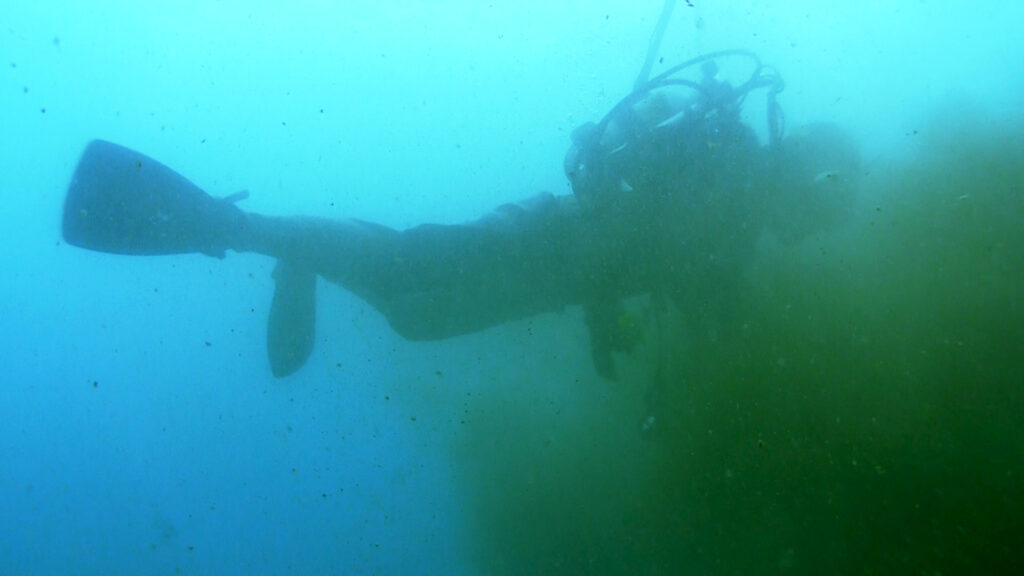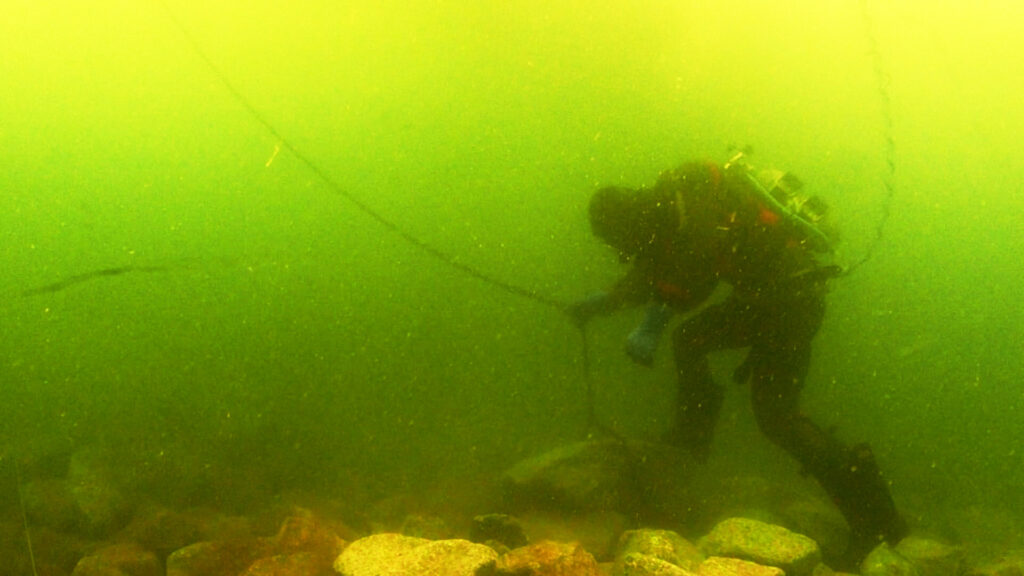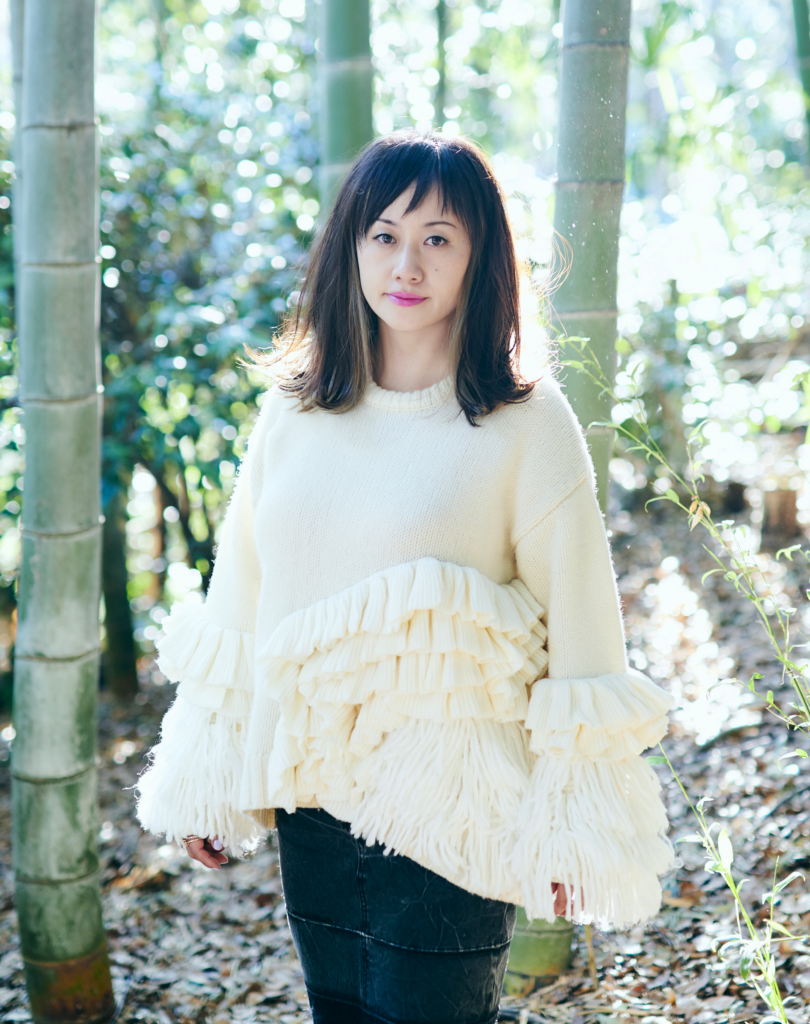
Friday 15 March – Sunday 31 March
Diver
Sung Nam Han
2021 / Japan
Salle Gilbert-Gaillard
Opening hours :
Tuesday to Saturday, 1pm to 7pm
Sunday from 2pm to 6pm
This post is also available in: Français (French)

Friday 15 March – Sunday 31 March
Opening hours :
Tuesday to Saturday, 1pm to 7pm
Sunday from 2pm to 6pm
In July 2019, when I directed “Art in Country of Tokyo (AICOT)” on the Tokyo islands, I met a father and son diver by chance. Then I started my research in December 2020, but I could not shoot them. Due to various aspects of the port construction work, including safety, outsiders are strictly prohibited from entering, and the divers kept refusing to be filmed, so almost gave up on the production of the work itself.


Credits :
Sung Nam HAN (Japan)
Single-channel video installation, 14’ 41’’, 2021
Interview by Fanny Bauguil, VIDEOFORMES relay teacher
Sparks sparking underwater, the earth shaking when a major earthquake occurs, the sun seen from underwater. As the depth gets shallower in a dive, the air expands and the tank becomes lighter, making it easier to float. Therefore, in one scene, a buddy is chasing the artist who surfaces suddenly in shallow water. Albino sea squart, bluefin squid eggs, and other “white” in the sea appear. Because white color stands out in the sea, it is easily attacked by foreign enemies and seldom survives. Tech sound arranged with the sound of the deep sea. Divers cleaning underwater, divers checking the condition of cars sunk underwater after the Great East Japan Earthquake, divers picking up earthquake debris. Sea urchins that cannot hibernate due to rising sea water temperatures caused by global warming devour seaweed attached to rocks. Divers exterminate the sea urchins, and high school students practice in traditional diving suits. Flames and smoke generated by underwater welding, etc.
As I filmed divers with the theme of humans and their labors in the sea, various topics came to me, such as deep-sea research, earthquake disasters, satoumi activities (increasing biological productivity and biodiversity by human interaction in the coastal area), environmental issues, SDGs, maritime archeology, gender, and sex.
“Diver” was originally made by a 5-channel video work and surround sound system and at the local ex- Gymnasium for Nakanojo Biennale 2021.
In July 2019, while directing a small arts festival called Art in Country of Tokyo (AICOT) on two islands in Tokyo, I met a father and son diver by chance. I was surprised that such a profession existed, and at the same time, I became interested in shooting their work someday.
I began to research in December 2020. However, in the end, I was not able to shoot the father and son (I later met another diver and his son!) Because port construction work is strictly forbidden to outsiders from various aspects, including safety, the divers kept refusing to be shot, and I almost gave up on the production of the work itself. I learned of the existence of volunteer divers who pick up marine debris and restore Isoyake (rocky-shore denudation), and of the only high school in Japan that trains divers to engage in underwater civil engineering work.
Interdisciplinary Art, Video Art, Media Art and Experimental
I was not able to shoot the father and son (I later met another diver and his son!) Because port construction work is strictly forbidden to outsiders from various aspects, including safety, the divers kept refusing to be shot, and I almost gave up on the production of the work itself.
It costs a lot such as travel expense and diving Expenses.
http://jonart.net/
https://www.youtube.com/@sungnamhan
https://nakanojo-biennale.com/2021/artist_channel/sung-nam-han/
Divers, sea, sea squirt, shooting under the sea, Deep sea sound, father and son of divers, labors in the sea, deep-sea research, earthquake disasters, satoumi activities, biological productivity, biodiversity by human interaction in the coastal area, environmental issues, SDGs, maritime archeology, gender, and sex. Physical restraints such as weightlessness. The only way to escape from the coronavirus is in the sea. Human Society in the Sea.
When I was 16 years old, I wanted to be a film director.
In my 20s, I made experimental films under the influence of personal and experimental films and presented them at film festivals in Japan and abroad. I distanced myself from the pursuit of individuality, and through philosophy books and my own love life, I honestly adopted the thoughts and ideas I had about love in my 20s, and began to create something universal. I came to believe this when I was exposed to the philosophy that emotions can be spoken through words. I believe that if words are symbols, then a series of symbols can fully explain the world, and that video is composed of symbols and expresses a story or non-story through a series of symbols.
In my 30s, I focused on video installations and performances. I have created the Blue Back series in various locations, using a technique called keying, a video synthesis technique in which a blue cloth is placed behind a person, the background is erased, and another video or other image is inserted. I see it as an act of partially missing space with an object in space. For me, blue represents nothingness. Blue also plays the role of imagination. The connection between two impossible things, between two things that are not real, and bringing different worlds into existence, is important in the work of the Blue Back series. I have also created works that challenge the viewer to extend the appreciation of art by creating a state of disturbance between sound and image, and by layering the work by making full use of switching to generate various timelines and layers of reality based on the idea of “Super Linear,” which I invented and have continued to develop.
While presenting my own works in the field of contemporary art in Japan and abroad, and interacting with independent groups abroad through three voluntary organizations, in her early 40s, she established the “Japan Undersea Art Museum” and plans to produce a new film work about the sea related to it.